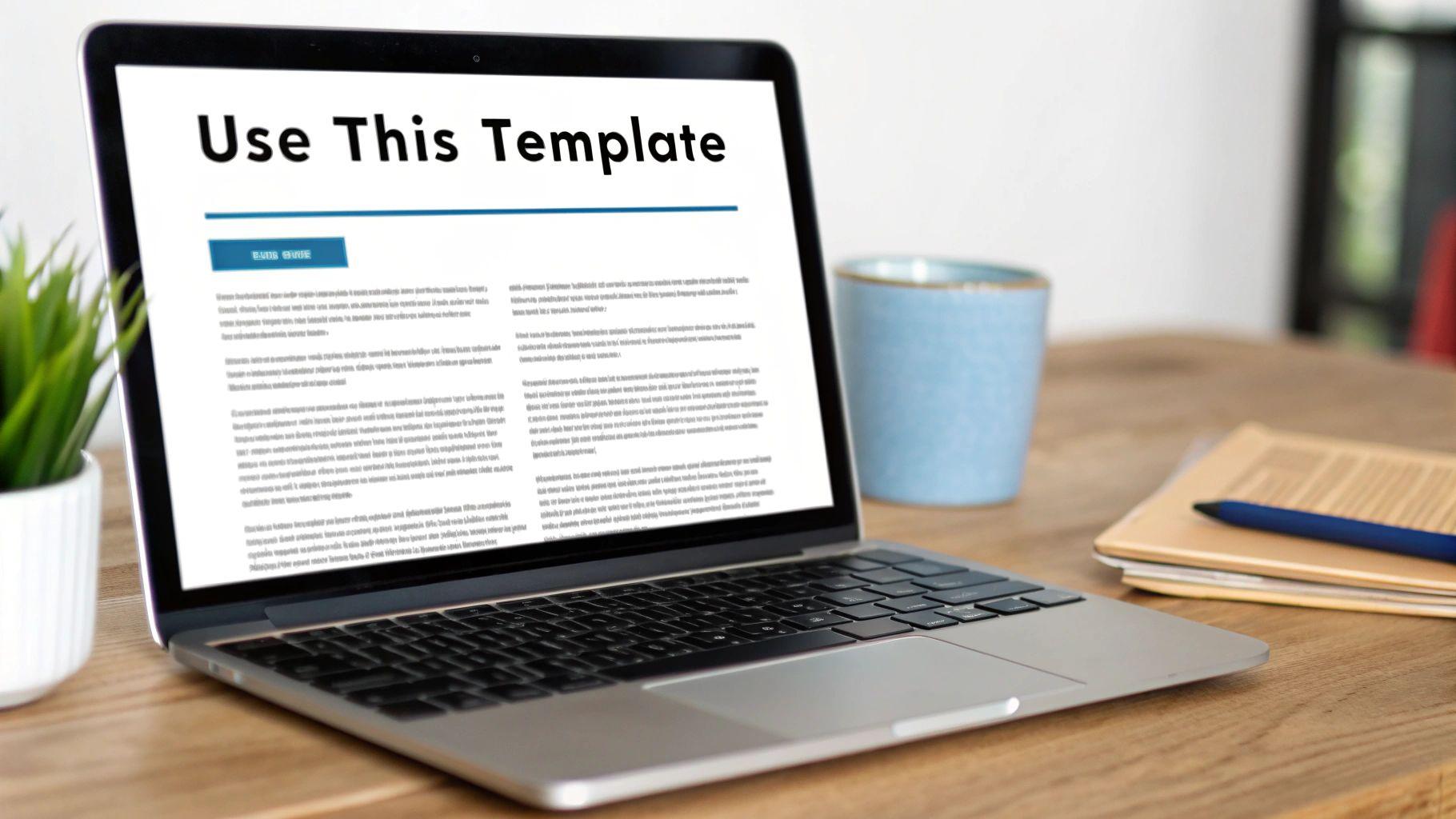Your Investor Update Email Template & Guide
Your Investor Update Email Template & Guide
Craft compelling investor updates with our expert guide and downloadable investor update email template. Build trust and drive follow-on funding.
Domingo Valadez
Oct 28, 2025
Blog
A great investor update isn’t just a numbers dump; it's how you build real relationships and turn your investors into your biggest advocates. The trick is to be consistent, brutally honest, and tell a clear story about where you are and where you’re going.
Why Investor Updates Are Your Secret Weapon

So many founders treat their monthly or quarterly update like a chore—another box to check on a never-ending to-do list. That’s a huge mistake. A well-written investor update is one of the highest-impact things you can do. It’s not just reporting; it’s about managing expectations, building momentum, and getting your supporters genuinely fired up.
This steady communication is the foundation of trust. When investors hear from you regularly, in good times and bad, it kills their uncertainty and shows you’re in control. That reliability is priceless when you need to go out and raise your next round.
More Than Just a Report
Think about it this way: the update forces you and your team to be accountable. The very act of pulling together metrics and writing down your progress creates a moment of honest reflection. It makes you ask the hard questions—what’s actually working? What isn't?—and brings a ton of strategic clarity.
Even better, a good investor update doesn't just inform; it mobilizes. Your investors are sitting on deep networks and decades of experience. They genuinely want to help you, but they can't read your mind. When you clearly lay out your challenges and make specific "asks," you turn a passive mailing list into an active extension of your team. This is a core concept in understanding https://www.homebasecre.com/posts/what-is-investor-relations—it’s a two-way street.
Turning Updates into Opportunities
I’ve seen this happen over and over. A founder once shared a "lowlight" about a key engineering hire falling through. Within hours, an investor on that list connected him to a perfect candidate who ended up joining the team. Another time, a startup mentioned they were struggling with a specific marketing channel. An advisor saw the update and immediately sent over a playbook that helped them slash their customer acquisition cost by 30%.
Your investor update is not a confession of your sins or a simple list of wins. It’s a tool to get your smartest, most connected supporters to help you solve problems. Don't waste that opportunity.
These aren't happy accidents. They are the direct result of consistent, transparent communication. When you start treating your update like a strategic asset instead of an obligation, you open up a powerful channel for advice, game-changing introductions, and support that can completely alter your company's path.
The Anatomy of a High-Impact Investor Update

A world-class investor update isn’t just a random collection of numbers and notes. It's a carefully crafted story, designed for a busy, sophisticated audience. Each piece has a specific job, from grabbing their attention right away to inspiring them to take action.
Getting this structure right is more critical than ever. With an estimated 376.4 billion emails flying around daily by 2025, your update is fighting for air in a very crowded room. And since over 60% of emails are now opened on a phone, a clean, scannable format is non-negotiable. If you're curious about the data, you can learn more about how to stand out in a crowded inbox and see what you're up against.
Let’s break down the strategy behind each section so you’re not just reporting facts, but building a powerful case for your company's future.
Start with a TL;DR Summary
Your investors are some of the busiest people you know. Respect their time by putting the most important information right at the top. Think of it as the executive summary of your month or quarter—the bottom line, upfront.
This section should be incredibly brief, maybe three bullet points or a short, punchy paragraph. It immediately answers the big question: "Was this a good period or a bad one?" This sets the tone and ensures they get the critical takeaways, even if they only skim the rest of the email.
- For example: "Overall, a strong Q2. We hit 95% of our revenue target and signed three major enterprise clients. We did face unexpected delays in our new feature launch, but we have a plan to get it back on track."
Showcase Your Key Metrics
This is the heart of your update, where the hard data lives. But please, don't just dump a spreadsheet into an email. Your job is to curate the 3-5 key performance indicators (KPIs) that truly tell the story of your business's health and momentum.
What you choose to highlight depends entirely on your business model. For instance, a real estate syndication platform like Homebase would likely focus on metrics such as:
- Deals Funded: The raw number of new properties closed.
- Total Equity Raised: The dollar amount of capital brought in by sponsors.
- Active Sponsors: The number of general partners actively using the platform.
- Monthly Recurring Revenue (MRR): If there's a SaaS component.
Present these cleanly in a simple table or a bulleted list. I always recommend including a comparison to the previous period (like month-over-month or quarter-over-quarter growth) to give the numbers crucial context.
Celebrate the Wins to Build Momentum
After the numbers, it's time to add some color and context. The "Wins" or "Highlights" section is where you share the good news that isn’t always captured by your main KPIs. This is how you build excitement and show forward momentum.
This isn't the place for vanity metrics. Focus on substantive achievements that demonstrate real progress against your strategic goals. Shipping a major product milestone is a win; a nice mention on social media is just a nice-to-have.
Solid examples of wins include landing significant press, hiring a game-changing team member, or securing a strategic partnership. Each win should be a concise bullet point that clearly explains its impact on the business.
Address Challenges with Transparency
This might just be the most important section for building trust. Every single startup runs into problems. Hiding them suggests you're either naive or, worse, dishonest. Tackling challenges head-on shows maturity and proactive leadership.
The key is to frame your "Lowlights" or "Challenges" constructively. I've found a simple three-step formula works wonders:
- State the problem clearly: "We missed our new user acquisition target by 15% this month."
- Explain what you learned: "Our paid ad campaigns underperformed due to a sudden increase in competitor ad spend on our core keywords."
- Outline your action plan: "We're reallocating 20% of that budget to content marketing and have hired a consultant to help us find more efficient channels for Q3."
This approach turns a negative into a powerful demonstration of your team's problem-solving skills.
Make a Clear and Actionable Ask
Finally, we get to the most underutilized part of an investor update: the "Ask." I can't stress this enough—your investors want to help you succeed. They have networks and expertise. But they can't read your mind. You have to tell them exactly what you need.
Vague requests are useless. "Any intros would be great" is easy to ignore. Get specific.
- Good: "We are looking for introductions to VPs of Engineering at Series B fintech companies. Does anyone in your network fit that description?"
- Great: "We're hiring a Head of Marketing. Here is the job description—we'd appreciate any referrals you think are a strong fit."
This is how you convert a passive report into an active tool for growth. By breaking down your update into these distinct, strategic sections, you create a powerful communication habit that strengthens relationships and actively accelerates your business.
To make this even easier, here’s a quick-reference table summarizing the key components we just covered.
Key Sections of an Investor Update Email
A summary of the essential components to include in your investor update for maximum clarity and impact.
Using this structure consistently will not only keep your investors informed but also turn them into a more engaged and valuable part of your team.
Turning Your Data Into a Compelling Story

Let's be honest, your investors are drowning in spreadsheets. They see data tables and KPI dashboards all day long. If your update is just another list of numbers, it’s not going to make an impact—it’s just more noise.
The magic of a truly great investor update lies in its ability to weave those numbers into a narrative. A story that connects the dots between your daily execution and your grand vision.
Numbers are meaningless without interpretation. Sure, 15% month-over-month user growth looks good on paper, but what does it actually mean for the business? Your job is to be the storyteller, to provide the crucial "why" behind the what. This is how you transform a routine report into a powerful tool for building genuine confidence.
By connecting the data to the story, you're showing investors you're not just a scorekeeper. You're the one pulling the levers, and you know exactly which ones are working.
Context Is Everything
A single metric can tell a thousand different stories. Was that spike in sign-ups from a brilliant marketing campaign you can scale, or was it a one-off fluke? Providing that color commentary is essential.
For instance, imagine your churn rate ticked up from 2.1% to 2.5%. Presented on its own, that’s a red flag. But with the right context, the story changes completely.
- Bad Framing: "Churn increased to 2.5% this month."
- Good Framing: "Churn ticked up to 2.5% this month, but we dug in and found it was driven entirely by a cohort of low-value, free-tier users from a Q1 promotional campaign. Crucially, our paid-customer churn remains stable at a healthy 1.2%, confirming our core product value is strong."
See the difference? The second version doesn't hide the bad news; it explains it. It shows you’re on top of the details and can separate a real threat from statistical noise.
Explaining Leading and Lagging Indicators
A sophisticated narrative also knows the difference between looking in the rearview mirror and looking at the road ahead. This means understanding and explaining both your lagging and leading indicators.
A lagging indicator tells you what has already happened (e.g., last month's revenue). A leading indicator hints at what’s coming next (e.g., a surge in sales-qualified leads).
Highlighting a strong leading indicator is one of the most powerful ways to build excitement and foreshadow future wins. It gives your investors a concrete reason to be optimistic about the next quarter.
Here's a practical example:
"While our new MRR was flat this month, the number of enterprise demos we booked is up by 40%. This is a direct result of our new outbound sales strategy and is a very strong signal for revenue growth in Q3."
Building a Narrative Around Your Goals
Finally, always tie your data back to the big picture. How does this month’s performance push you closer to your annual goals? How does it line you up for your next funding round? Each update should feel like a new chapter in an ongoing journey.
Instead of just presenting isolated metrics, frame them as progress against a defined objective. This helps everyone see not just where you are, but where you're headed. It’s the difference between showing someone a single puzzle piece and showing them how it snaps perfectly into the final image.
Tell this story consistently, and you'll keep your investors engaged, informed, and excited for what comes next.
Practical Tips for Sending Your Update
Crafting a compelling message is only half the battle. If your email never gets opened or is too dense to read, all that strategic storytelling goes to waste. The small details—how and when you send your update—are what separate a message that lands with impact from one that gets lost in the noise.
And make no mistake, email is the right channel. An incredible 99% of people check their inbox at least once a day. With over 4.48 billion email users worldwide, this direct line to your stakeholders is too valuable to mess up. It’s a proven method for high-stakes communication, which is why 81% of small businesses already lean on it to connect with customers.
Finding Your Cadence
The first question I always get from founders is, "How often should I send this?" For most early-stage startups, monthly is the gold standard. It’s the perfect frequency to show real, tangible progress and build a consistent rhythm of accountability.
Once your company matures and your strategic cycles get longer (think Series B and beyond), switching to a quarterly cadence can make more sense. The specific interval isn't what matters most; consistency is.
Pick a schedule and stick to it religiously. An investor who knows to expect your update on the first Tuesday of every month will start to look for it. That kind of consistency builds immense trust and shows you're a reliable operator.
Writing Subject Lines That Get Opened
Your subject line is the gatekeeper. A boring or generic one is a surefire way to get ignored. It needs to be informative and, just as importantly, easily searchable for an investor who wants to find it three months from now.
I've found a simple, effective formula that works every time: Company Name // Update // Month Year.
For example: "Homebase // Investor Update // October 2024".
It’s clean, professional, and instantly recognizable. The recipient knows exactly what it is and who it’s from, making it far more likely to be opened right away. To learn more, you can read up on these key email subject line best practices to make sure every send counts.
Simple Formatting for Scannability
Investors are scanners, not deep readers. They’re busy. Your job is to make your investor update email template as easy to digest as possible, especially on a phone.
- Use Bold Text: Make key metrics (+12% MRR), important takeaways, and specific asks pop off the page.
- Embrace Bullet Points: They are your best friend for breaking up long walls of text. Use them for wins, challenges, and your asks.
- Keep Paragraphs Short: Seriously, no paragraph should be longer than three sentences. White space is not your enemy; it makes the email feel less intimidating.
By focusing on these practical sending tips, you ensure that the hard work you put into crafting your narrative actually pays off with an engaged and informed group of supporters.
Your Go-To Investor Update Template

Alright, here it is—a battle-tested template you can put to work immediately. This isn’t some flimsy outline. It’s a complete framework designed from experience to be clear, scannable, and genuinely helpful for your investors.
I’ve filled it with practical placeholders and prompts, so you know exactly what information to drop into each section. Just copy the text below and tweak it to fit your company's voice and unique metrics.
Whether you're a pre-seed startup that just landed its first paying customer or a Series A company navigating complex enterprise sales, this structure is flexible enough to work for you. The goal is to make this process painless, so you can build a consistent rhythm of communication without spending hours staring at a blank screen.
The Plug-and-Play Template
Subject: [Your Company Name] // Investor Update // [Month Year]
Hi Team,
TL;DR: [A few quick bullets summarizing the period. Was it a good, bad, or mixed month? Give them the top-line story right away.]
* Example: Hit 95% of our revenue target and signed three major clients.
* Example: Faced unexpected delays in our feature launch but have a clear plan to get back on track by [Date].
Key Metrics (KPIs):
* MRR: $[Amount] (X% MoM growth)
* New Customers: [Number]
* Customer Churn Rate: [Percentage]
* Cash in Bank / Runway: $[Amount] / [Number] months
Wins / Highlights:
* [Win 1: Briefly describe a key achievement. Ex: "Landed our first international customer in the UK, validating our expansion thesis."]
* [Win 2: Mention a product or team milestone. Ex: "Successfully shipped our new analytics dashboard, which was our #1 customer feature request."]
* [Win 3: Share a press mention, partnership, or hiring win.]
Challenges / Lowlights:
* [Challenge 1: State the problem, what you learned, and your plan. Ex: "We missed our new user acquisition target by 15% this month due to rising ad costs. We're reallocating 20% of that budget to content marketing for Q3."]
The Ask:
* [Be specific and direct. Ex: "We are hiring for a Senior Software Engineer. Here is the job description [link]—we'd appreciate any referrals you think are a strong fit."]
Best,
[Your Name]
Making the Template Your Own
This structure is effective because it’s built on clarity and respects the investor's time. Think of it less like a formal report and more like a concise briefing. In fact, many of the same principles apply to both investor updates and internal check-ins. You can often find great ideas for structuring your data by looking at an effective quarterly business review template.
Never underestimate the power of a simple email. It's an incredibly efficient tool for managing these critical relationships. Research shows that email delivers an average return of $36 for every $1 spent, which is an astronomical 3,600% ROI. This makes your investor update one of the most cost-effective channels you have. Mastering it is well worth the effort.
A Few Common Questions I Get About Investor Updates
Even with the best template in hand, you're going to run into weird situations. Knowing the basic structure is one thing; navigating the tricky, real-world scenarios that pop up is another. Here are the questions I see founders wrestle with most often, along with some straightforward advice.
How Often Should I Actually Send This Thing?
For most startups—think pre-seed all the way through Series A—the answer is monthly. It's the perfect rhythm. Sending an update every month is frequent enough to show real progress and keep your company on their radar, but not so often that it becomes a burden for you to write or for them to read.
Once your company is more mature and your operating cycles are longer, you can probably shift to a quarterly cadence. But honestly, the specific interval isn't nearly as important as the consistency.
Pick a schedule and own it. An investor who knows your email will land in their inbox on the first Tuesday of every month will start to look for it. That kind of discipline builds a ton of trust and quietly signals that you’re a serious, reliable operator.
What Do I Do If I Have to Share Bad News?
You share it. Period. And you share it before they can hear it from someone else.
Nothing craters an investor relationship faster than them finding out about a major problem from a third party. Or worse, being blindsided by an issue that's been festering for months and has now become a full-blown crisis. They've been around the block; they know setbacks are part of the game.
The trick is to tackle it head-on in your "Lows & Challenges" section. Don't try to soften it or bury it at the bottom.
- State the problem clearly: "We churned our largest customer this month, which is a $10k MRR hit."
- Show you understand why: "Our post-mortem showed a critical failure in our enterprise onboarding process."
- Explain what you’re doing about it: "We've already rolled out two new checkpoints in the onboarding flow and are proactively meeting with our other top five customers to make sure this doesn't happen again."
When you frame bad news with a clear-headed action plan, you demonstrate leadership and resilience. It shows you own your mistakes, which is exactly what an investor wants to see.
Should I Send the Same Update to All My Investors?
Yes, 99% of the time, everyone should get the exact same email. It’s just simpler and more transparent. A single, standardized update ensures every stakeholder has the same information at the same time. Nobody feels left in the dark or like someone else is getting special treatment.
The one tiny exception is your "Asks." While the main body of the update goes out to the whole list, your requests for help should be handled differently. Send a personal, one-on-one follow-up email to the specific person you think can help you. That personal touch makes it a whole lot harder for them to ignore your request.
Is It Okay to Add a Bit of a Personal Touch?
You absolutely should! While your investor update email template should be packed with hard data and professional insights, don't forget that your investors backed you. The person. The founder.
A quick, personal opening about a team win, a tough lesson you learned, or just a brief reflection on the journey makes the whole thing feel more human. It helps build the personal connection that supports the professional one. Just keep it short, authentic, and tied to the company's story.
Ready to manage your real estate deals and investor relations without the spreadsheets? Homebase provides an all-in-one platform to streamline fundraising, reporting, and distributions, so you can focus on closing deals and building stronger relationships. Learn more about how you can simplify your syndication.
Share On Linkedin
Share On Twitter
Share On Linkedin
Share On Twitter
DOMINGO VALADEZ is the co-founder at Homebase and a former product strategy manager at Google.
What To Read Next
Your Guide to the Real Estate Syndication Structure
Blog
Explore the complete real estate syndication structure. This guide breaks down legal entities, waterfall distributions, and investor roles for your next deal.
Sign up for the newsletter
If you want relevant updates from our team at Homebase, sign up! Your email is never shared.
Sign up for the newsletter
If you want relevant updates from our team at Homebase, sign up! Your email is never shared.
© 2025 Homebase. All rights reserved.